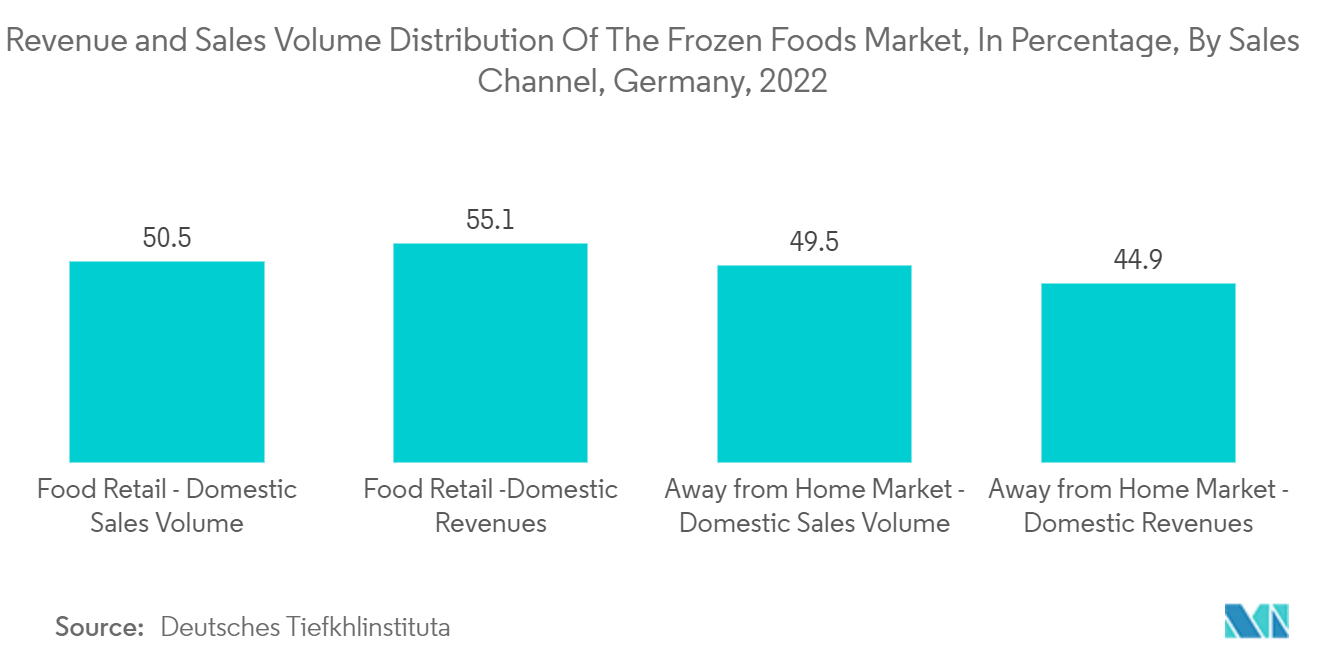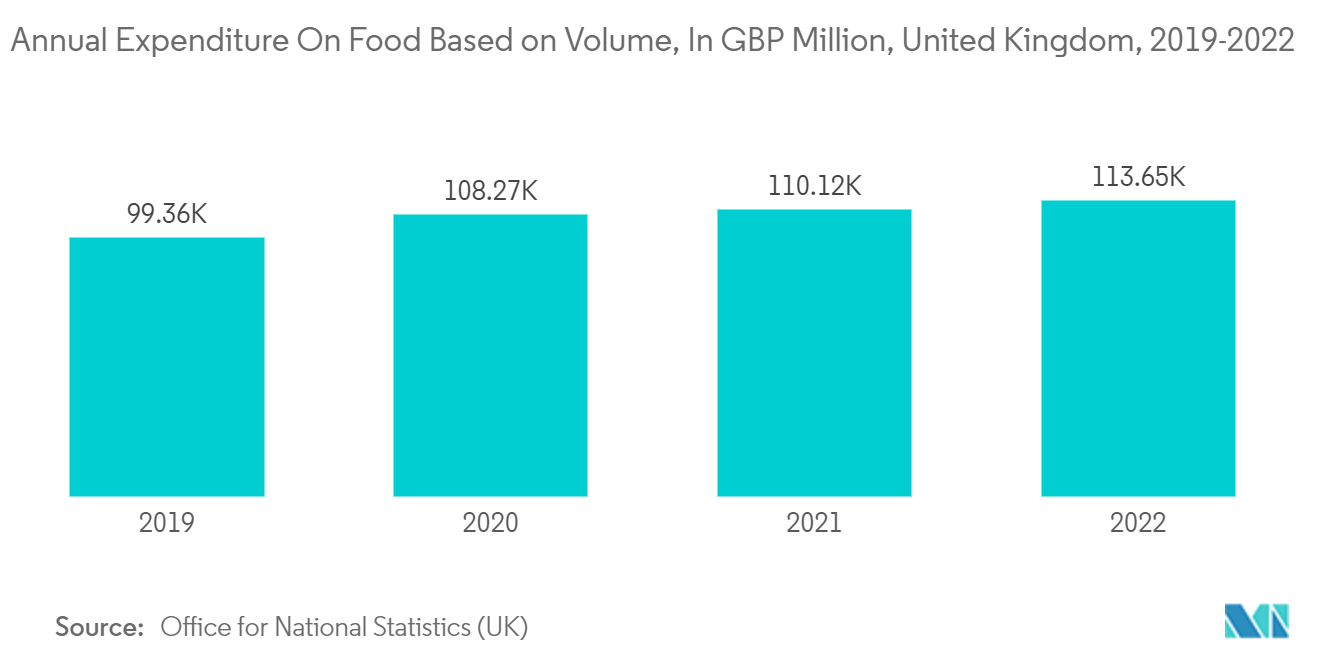Market Trends of Europe Flexible Packaging Industry
Food Segment is Expected to Drive the Flexible Packaging Market in the Region
- Flexible packaging is a lightweight alternative that saves costs associated with production, damage, parts, returns, disposal, and transportation by allowing material processors to ship more products in less quantity. This is the ideal solution for food packaging. In addition, many small businesses in the region are looking for better protection with longer shelf life against various types of food spoilage, such as air, moisture, and sunlight, increasing the demand for flexible packaging.
- The demand for packaged food products is rising quickly due to working professionals' growing time limitations and the availability of more convenient food options. Packaged food products provide better barrier protection, containment or accumulation, advertising, detailed ingredient information, safety, appropriateness, and other benefits. As a result, the demand for packaged foods and the growing inclination for online shopping is expected to drive growth in the worldwide e-commerce packaging market throughout the forecast period.
- According to research conducted by Voyado, the proportion of consumers who made their first-ever online grocery purchases during the pandemic is Spain at 30%, France at 22%, the United Kingdom and Italy at 20%., Sweden and Denmark at 14%, Finland at 11%, Poland, Netherlands, Belgium, Germany at 10%, and Norway at 9%. Also, 68% of new customers who buy groceries online confirmed that keep doing so in the future. Consequently, this shift in people's habits has positively impacted the barrier film packaging market.
- A study published in the British Food Journal revealed that families that switched to frozen food reduced their food waste by over 47%. As a result, consumers are also moving to frozen food to reduce the amount of trash they produce. This shift to frozen food will spur market expansion. The demand for frozen food bags is rising due to several causes, including changing lifestyles, increasing disposable income, and the quick urbanization of developing nations, particularly the expanding middle-class population.
- The rising trend towards e-commerce is driving the growth of the market. The expansion of e-commerce has significantly impacted the frozen food business in Europe. Online retailers are leveraging extensive digital capabilities to offer a wider range of frozen foods and ship them directly to consumers' homes, making it easier for customers to purchase and source these products. The convenience of home delivery, the ease of online ordering, and the possibility of real-time order tracking are all driving the expansion of the frozen food market.
- Moreover, the rapid development of grocery chains, supermarkets, hypermarkets, and convenience stores and the increasing availability and quality of products are some of the primary drivers of the industry. In addition, the strong growth of the food industry and the rising employment rate is also important for the rapid growth of the frozen food industry in Europe.

United Kingdom to Witnesses Significant Growth Opportunities in the market
- Growing urban populations in the United Kingdom, and altered lifestyle patterns, such as less time spent on meal preparation, are driving a shift towards more processed, conveniently packaged, and pre-prepared foods and snacks, which is anticipated to drive the growth of the market under study. Additionally, because flexible packaging solutions can extend the shelf life of such products, the rising demand for packaged foods, ready-to-eat foods, frozen foods, and luxury foods is projected to enhance the need for these solutions nationwide.
- Due to a rise in demand for packaging services in the UK due to the rising industrial sector, the packaging industry is growing dramatically. The Packaging Federation of the United Kingdom estimates that the UK packaging manufacturing sector had yearly sales of GBP 11 billion (USD 13.59 billion). More than 85,000 people are employed there, which is 3% of the manufacturing workforce in the UK.
- The increased demand for flexible packaging solutions for tobacco, pet food, and homecare solutions drives the need for flexible packaging in the rest of the end-user verticals in the United Kingdom during the forecast period.
- The use of flexible plastic packaging has increased in the United Kingdom due to rising recycling rates. United Kingdom Statistics on Waste, released in July 2022, states that the nation's recycling rate for packaging waste improved from 59.2% in 2014 to 63.2% in 2021. The country's use of flexible plastic packaging is being fueled by initiatives taken by private parties, which are also assisting in improving the recycling rate.
- In addition, the market is expected to be significantly impacted by the tightening of plastic usage laws. For instance, the United Kingdom's Plastic Packaging Tax (PPT), which went into effect on 1 April 2022, is charged at a rate of GBP 200 (USD 247.7) per metric ton of plastic packaging in the United Kingdom that has less than 30% recycled plastic content. The tax intends to promote the use of more environmentally friendly plastic packaging, boost the utilization of recycled plastic, and aid in reducing plastic waste.
- Consumers across the nation believe that e-commerce is not ecologically beneficial because of the gas emissions from deliveries and returns. In a survey conducted in 2022 by Aquapak, a manufacturer of specialized polymers that develops products to promote a circular economy, more than half (52%) of United Kingdom customers stated they would be ready to pay more for ecologically friendly packaging when buying clothing and accessories. One-third of those prepared to pay extra indicated they would increase the price by 1% to 4% to receive their items in sustainable packaging, while nearly two-fifths (39%) said they would pay an additional 5%. 15% of respondents said they would be willing to spend an extra 10% to 20%, while 8% said they would pay an additional 6% to 9%.

